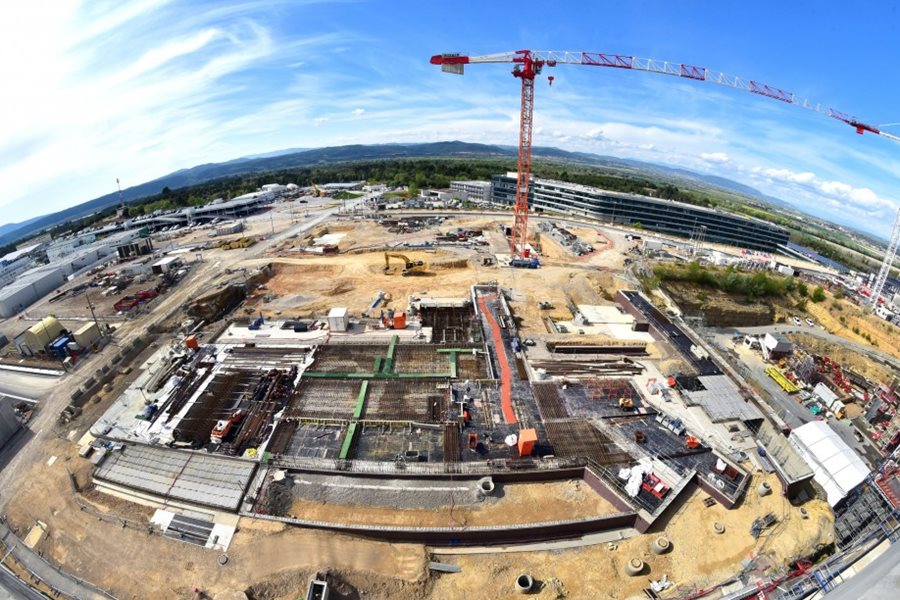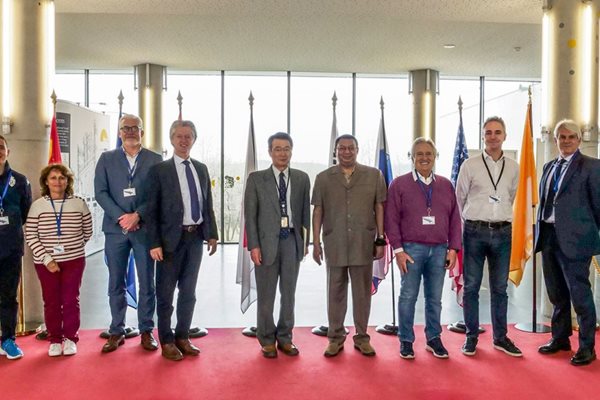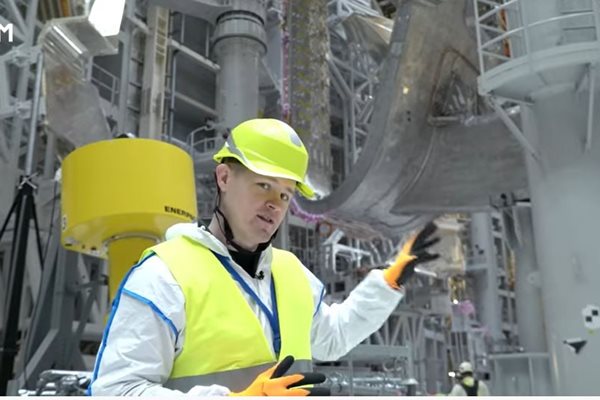
you're currently reading the news digest published from 11 Apr 2022 to 25 Apr 2022
featured2
of-interest2
press25
featured
On site | "The building works required for First Plasma are 85% complete"
As the European Domestic Agency Program Manager for Buildings, Site Infrastructure and Power Supplies, Laurent Schmieder has been in charge of the construction of the ITER scientific facility since 2009. From a flat and empty stretch of land 13 years ago, the ITER platform today is a crowded and busy place—with 85% of the infrastructure required for First Plasma in place. Newsline caught up with Schmieder and his deputy Romaric Darbour in April just as one of the final paved roads of the platform had been finalized. Can you remind us of the scope of European Domestic Agency (Fusion for Energy) responsibility in the construction of ITER? Europe, as part of its commitments to the project, is building nearly all of the platform buildings and site infrastructure, which includes 39 buildings and technical areas. Scope includes the civil engineering of buildings; site infrastructure works (drainage and technical galleries), handling items such as cranes, electrical distribution, and site adaptation works such as roads, signage and lighting. The Tokamak Complex (which reunites the Tokamak, Diagnostic and Tritium buildings on a single foundation) has been the largest-term project so far: it took four years to prepare the foundation of this 430,000-tonne structure, and we have been building up since then. For two years now, the construction of the ITER scientific facility has continued despite COVID-19. In hindsight, what were the biggest challenges of this period and what overall conclusions can be drawn about the effect of the pandemic on ITER construction? The biggest challenge I'd say was to learn how to work within new safety constraints. On a worksite like ITER, the safety level is already high and workers are used to following safety instructions. But the pandemic imposed all kinds of new constraints. It was not easy to evaluate the consequences of the new work environment on the productivity and also the mental health of the staff. This was made even more problematic in the context of teleworking. Coordination from afar was just not possible, we concluded, and so technical responsible officers came on site as much as they could to follow construction progress and to run in-person meetings, within safety boundaries of course. Despite the complications COVID-19—and thanks to the ITER Director-General's actions that protected the workers while also allowing work to move forward—we can say in general that we were able to continue steady progress on the worksite and meet our principal milestones. The foundations of the ITER Tokamak Complex were built between 2010 and 2014; since 2014 the Complex structure has been rising. What is the status of the Tokamak Complex today and how close are we to completion? All structural works for the Tokamak and Diagnostic buildings have been delivered and the secondary works are nearly achieved. Painting is completed at all levels, and we are now in the touch-up phases. Door installation is complete, with only some last fine-tuning to perform. Other small finishing works—such metallic platform installation, concrete plinths, and false floor erection—remain, but by summer 2022 these finishing works will be behind us. It is important to note that Tritium Building construction—which had been on hold since 2017 in order to focus all efforts on the delivery of the Tokamak Building—resumed in 2021 and we expect to have this building completed by mid-2024. The construction of the installation has proceeded by work package, or 'tender batch (TB).' How many tender batches have been completed and how many are in progress or remain to be awarded? What percentage of the work scope has been completed (for buildings and infrastructure required for First Plasma)? Of 17 tender batches, nine have been completed and eight are ongoing. The building program works required for First Plasma have now reached 85% completion. We are nearing the end of the site infrastructure contract TB16 (service trenches, precipitation drainage, and site adaptation works such as roads and lighting), which has been running since early 2016. In a recent milestone, the team completed the final paved road of the platform. (See image below.) The F4E team has been assisted from the beginning on site by architect/engineer ENGAGE and worksite safety contractor APAVE. How has the collaboration worked and how do you keep the different elements of the team on the same page? We have learned to work together, adapting progressively to cultural differences and building on them to reinforce the performance of our team. This has allowed us to resist in times of difficulty or crisis—for example, when dealing with additional requests for justification before the start of a project, managing unexpected complexity or cost, or coping with unexpected situations like the pandemic or geopolitical instability that has affected the availability of raw materials. All this has reinforced the team spirit and has increased the team's motivation to deliver. ITER is a big family and all together we have been able to contribute and to support one another. We also coordinate closely with our ITER construction colleagues through the Buildings Infrastructure and Power Supplies (BIPS) Project Team. There is a lot of ITER infrastructure that is not visible to the naked eye—technical galleries, utility networks, drainage tunnels. What can you tell us about this 'underground world' that is absolutely critical to ITER operation? ITER is a bit like an airport: the visible part represents only a small fraction of the works. The underground networks are huge, with more than five kilometres of galleries linking all the buildings and also hundreds of kilometres of networks for the distribution of electricity, water and other fluids. It was a real challenge to manage the construction of all these underground works while at the same time other contractors were building massive structures above ground. Good anticipation and coordination between our teams and contractors was a key factor of success. How many people have contributed to the building of ITER since 2010? We can evaluate that more than 15,000 people have contributed to ITER site construction. Some 5,000 companies, from approximately 10 European countries, have been involved. At the time of this interview, there have been no major accidents and we have not had to report casualties in relation to work on site. The statistics on the worksite (accident frequency rate) are four times better than the French statistics—a big success even if in the area of safety, continuous improvement is essential. We are tracking any 'near misses' to improve our processes, to build on lessons learned and to improve our level of safety. How has the presence of Fusion for Energy staff and contractors evolved over 13 years of construction? How big is the Fusion for Energy team managing the remaining activities and what are your projections for the coming years? Fusion for Energy activities have change over the time and—while we are at 85% of First Plasma needs—we have reached only 60% of the entire work scope. The BIPS team remains stable (in the range of 80 staff—half from Fusion for Energy and half from the ITER Organization); it will remain mobilized at the same level for the challenges to come. Looking ahead, we have to complete the civil works of the Tritium Building (three more levels to go), finalize a set of buildings necessary for secured power distribution, and complete the ITER Control Building, building services in auxiliary buildings, and technical bridges that will bring electricity and cryogenic fluids into the Tokamak Complex. Another masterpiece will be the ITER Hot Cell facilities, which have a volume and a level of complexity comparable to the Tokamak Complex. So although we have already reached the middle of this long journey, even more challenging activities remain ahead of us!
OPEC Secretary General: "I am convinced the world needs ITER"
On Thursday 21 April, the ITER Organization was honoured to welcome the Secretary General of OPEC, the Organization of the Petroleum Exporting Countries. His Excellency Mohammad Sanusi Barkindo is a seasoned diplomat and executive with extensive experience in the global energy industry and a keen sense of how trends and fluctuations in global energy markets impact both developed and developing country end users—including those who currently have no access to electricity. "Energy is the lifeblood of civilization; the prosperity that we see in many parts of the world can be attributed to energy availability," he commented during his visit. "We don't need to be convinced that we need all sources of energy; no one can say otherwise.' "There is a misinterpretation of the basic principles of the energy transition. The current conversation is distorted to some extent, that it is a transition from one set of energy sources to another, from fossil fuels to renewables. This is a distortion of the science, the facts, and the data. The transition is about moving from emissions of greenhouse gases to a decarbonized world, driven by technology, policies, corporate decision-making, and much more.' The Secretary General travelled to ITER as part of a delegation led by Peter Kütemann, Chairman and CEO of Dietsmann, a global energy company that also contracts with ITER. The nine-person delegation was led on a tour of the ITER construction site, especially the Assembly Hall and Tokamak pit where giant ITER components are in various stages of assembly and installation. "No matter how much one reads on the ITER website, it does not prepare you for what you witness in a personal tour. In the Assembly Hall, I was speechless at what I saw—the enormous engineering, the collaboration among all these countries. I spoke to as many workers as I could, and they were all of different nationalities. The common language is science, mathematics, and computing. I could see that in action inside the Hall.' "I see ITER as the future. I am convinced that the world needs ITER, for the simple fact that we do not have enough clean energy supply to meet current demand and future needs.' The Secretary General pledged to use the influence of his office to help raise of the promise of ITER and fusion. 'This is what the world should focus on,' he concluded. 'Because of what I have seen today, I can see, clearly, light at the end of this dark global tunnel, that promises to address the global energy transition, that promises to address the global pandemic of energy poverty.'
of-interest
Registration opens for the 2022 ITER International School
Registration is open now for the 11th ITER International School. This in-person event will be held from 25 to 29 July 2022 at the University of California San Diego, hosted by the U.S. Burning Plasma Organization, the ITER Organization, UC San Diego, and General Atomics. The subject of this year's school is "ITER Plasma Scenarios and Control." As the start of ITER operation approaches, it is timely to address this challenging multidisciplinary topic: the development of integrated operating scenarios and required plasma control to facilitate the ITER goals, particularly for plasmas self-heated by fusion-born alpha particles. Most attendees will be graduate students, post-doctoral researchers, and early career faculty and research staff working in fields relevant to the ITER program. Although the agenda will focus on topics of scenarios and control, attendees are not required to be working in these subfields. All nationalities, whether representing an ITER Member or not, are welcome. The ITER International School is organized regularly with the goal of giving young scientists and engineers a taste of the stimulating, multi-disciplinary and challenging field that is nuclear fusion. For all information on the 2022 edition and to register, see this webpage.
The B1M construction channel visits ITER
The B1M—the world's largest, most subscribed-to video channel for construction—aims to inspire people to join the construction industry by showcasing the incredible projects and feats of engineering it delivers. In March 2022, the team came to ITER. The result is an entertaining and educational nine-minute video that takes you into the very heart of ITER machine construction. "This is so much more than just an energy project; it's a $22 billion science experiment between a whole host of nations all coming together to try and change how we generate power on this planet," says host Fred Mills as he guides the viewer through a maze of components and tooling in the ITER Assembly Hall. Colette Ricketts, deputy head of the ITER Project Control Office, also makes a cameo appearance to explain how the arrival of components from the ITER Members is planned and managed ... and re-planned if necessary, as when international events have an unexpected effect on manufacturing or shipping. "It's a pretty nuclear level of project collaboration," says the B1M team. "It's kind of like building a LEGO kit ... just 10 million times more complicated." Watch "We Went Inside the Largest Nuclear Fusion Reactor" on YouTube here.



